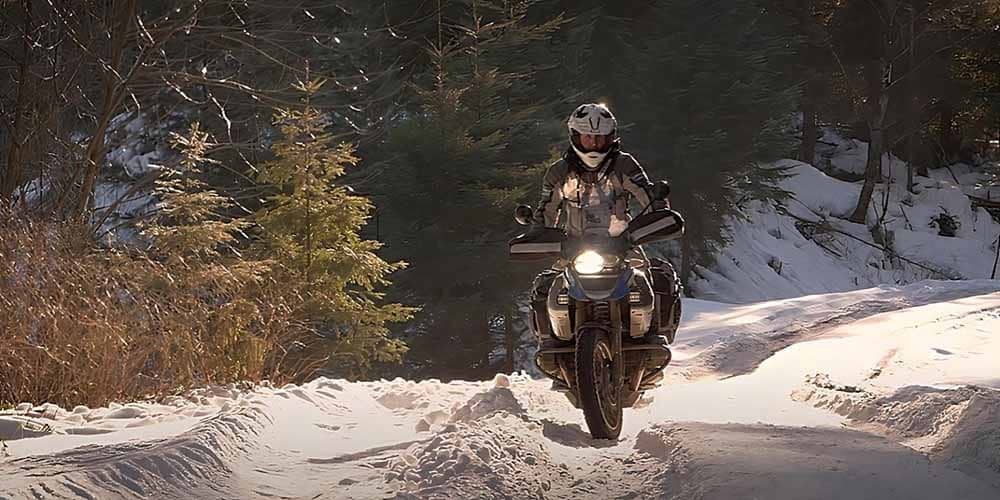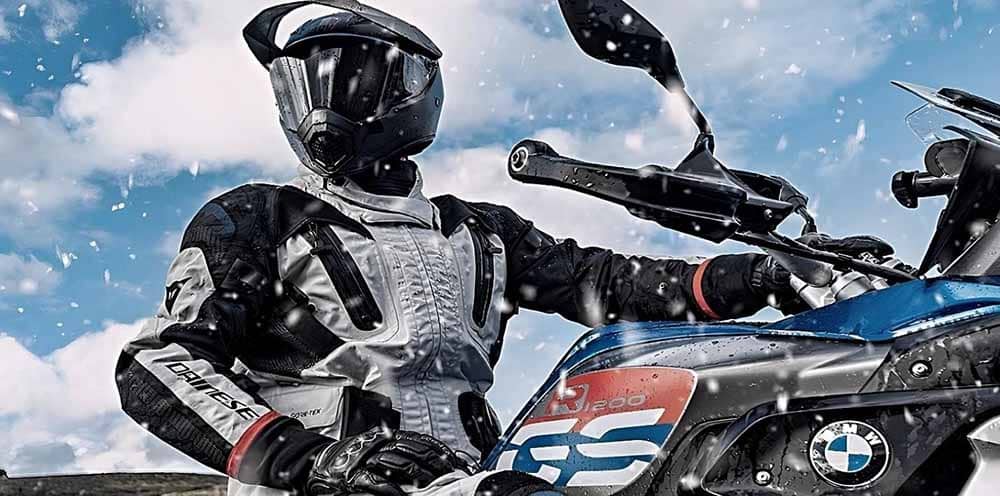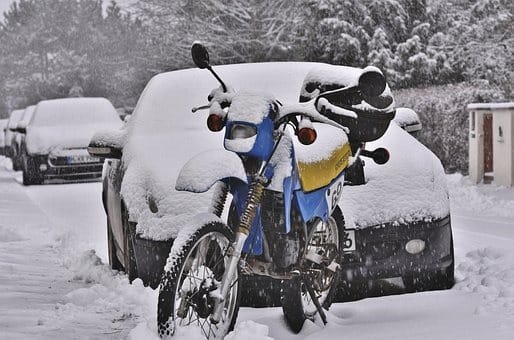Brace yourself for the ultimate showdown between man and machine in the battle against extreme temperatures! Yes, motorcycles can survive a wide range of temperatures. Some will even run at the most extreme high temperatures of 180-220 °F and cold temperatures of -25 to -34 °F if adequately tuned. But this doesn’t imply it’s safe to ride; your internal thermostat cannot match that temperature range, so worry more about pushing your limits than the bike. And this begs the question, what weather is too cold to ride a motorcycle?
Well, it’s simple—anything below 32°F (0°C or 273K) is considered too risky for a safe and enjoyable ride! You perhaps should avoid motorcycle riding when the temperature is below the freezing point of the water. During an extreme cold event, your body must work extra hard to regulate a normal body temperature, which could lead to illness or a fatal accident. Even though it’s too cold to ride a motorcycle, that doesn’t mean you have to put your passion on hold.
You can prepare yourself for winter riding. You need to enjoy the chain that sets free even in the colder months of the year when you need it the most. But remember, your own tolerance to the cold is the deciding factor.
My Temperature Quick-Reference Chart to Help You Understand Your Limits
| Temperature | Safe for You? |
My Advice |
| 50 °F or More | Yes | Some riders avoid riding in temperatures of 55 °F or below, but it’s safe. Cover up with thick gloves, a warm jacket, insulated windbreaker pants, and/or a scarf. |
| 49 to 40 °F | Yes | 49 to 40 °F is still safe to ride, but it can get cold. And you’ll need to properly cover your feet, head, and hand. |
| 39 to 30 °F | Yes | Rides in temperatures of 39 to 30 °F can be colder and more dangerous in long rides. Limit yourself to less than an hour in such temperatures if you want to avoid risks of hypothermia and frostbite. |
| 29 to 20 °F | Yes | At temperatures of 29 to 20 °F, you will likely experience ice and snow. Mild risk of frostbite and hypothermia. |
| 19 to 10 °F | Maybe | Temperatures of 19 to 10 °F might be safe but dangerous if you stay for too long in the open. Put on warm motorcycle apparel to avoid a moderate risk of frostbite and hypothermia. |
| 9 to 0 °F | Maybe | Lower temperatures of 9 to 0 °F can be much colder for long-distance riders due to windchill. Avoid riding under such conditions. High risk of frostbite and hypothermia. |
| (-1) to (-9) °F | Maybe | Riding in temperatures of (-1) to (-9) °F is hazardous to your health. A few riders may attempt to ride, but the rides must be short and wear lots of layers. Extremely high risk of frostbite and hypothermia. |
| (-10) to (-19) °F | No | Even with several layers of clothing, there is a high risk of cold-related ailments. Unless you have to, don’t attempt to ride in (-10) to (-19) °F temperatures. |
| 20 °F and Below | No | Don’t attempt to ride during these conditions. It’s unsafe for any rider. |
What You Risk in Cold Weather Motorcycle Riding

Your cold tolerance limits the far you can go on a motorcycle in winter, i.e., you are likely to throw in the towel sooner than your bike. Here are some dangers to be wary of:
Windchill
The windchill is one of the most important things to consider. Despite the thermometer’s reading, riding around will seem much cooler. You’ll lose body heat while riding and won’t be able to regain it until you stop (depending on your attire). You can shiver even on warm days!
With just a touch of breeze, even temperatures in the double digits might feel negative. Some motorcycles can achieve up to 100 mph, causing significant wind chill. So, if you’re going fast, stay warm.
My Top Recommended Trailers & Transport — CLICK HERE! I highly recommend these motorcycle trailers for their affordable yet top-notch quality, reflecting my extensive 50+ years of motorcycling experience and expertise as a rider, leader, and consultant in 25+ countries. So, whether you're a seasoned rider seeking an upgrade or a new enthusiast starting your journey on two wheels, I'm confident that these gear recommendations will serve you exceptionally well. |
Hypothermia
Motorcycle riders must also watch out for hypothermia. One of the main reasons to keep winter rides to an hour or less. Long travels (particularly in wooded/rural locations) increase the risk of hypothermia. You’re in jeopardy if your body temperature drops below 95 °F.
You can’t elevate your body temperature if you’re away from home or in other heated regions. When you see danger, you must turn around and return. In the cold, you’ll likely get worse on the way back.
You’ll be at considerably more risk if it rains or snows. Wetness saps heat faster! It’ll be difficult to focus and control your bike, and you may shake uncontrollably.
Frostbite
Frostbite poses another threat when riding in the cold. Although frostbite does not impact important organs like hypothermia, it can harm your fingers, toes, nose, ears, and other extremities. Your fingers will grow numb if you don’t have gloves or other protection on your handlebars! Hands are one of the most exposed regions of the body due to the wind chill and the placement of your hands on a bike.
Pay attention to your body to detect frostbite. Numbness, stiff joints, or prickling in certain regions (especially exposed areas) can all be warning indicators. Frostbite makes you numb and clumsy. This is risky when riding!
Frostbite can be avoided by dressing warmly (or at least starving them off until your ride is over). Putting on heated garments and gloves can help.
Other Risks Include:
-
- Reduced Visibility: Fog and low clouds are common in cold weather, which can reduce visibility for motorcyclists. It is important to use your headlights and be extra vigilant when riding in these conditions.
- Fatigue: Cold weather can lead to fatigue, especially if the rider is not dressed appropriately. It is important to take regular breaks and stay hydrated to prevent fatigue while riding in cold weather.
- Increased Risk of Accidents: Cold weather can make roads slippery and increase the risk of accidents. It is important to reduce speed and be extra cautious when riding in cold weather.
By taking precautions and being aware of the potential dangers, motorcyclists can stay safe and healthy when riding in winter.
Related Post:
How Cold is Too Cold to Ride a Street Bike? 6 Great Indicators That It is Way Too Cold
Preparing for the Cold Weather Motorcycle Ride

If you’re riding in cold weather (60 degrees or less), wrap up! Layers can help prevent cold-related illnesses and make riding more enjoyable.
Cold rides require layers. And a decent fundamental outfit guideline is:
-
- Top and bottom long thermal underwear. Wicking moisture is vital
- Waterproof and windproof outer layer. Textile jackets and pants are ideal
- Thick waterproof socks. Choose fleece-lined or wool
- Good grip riding gloves. An added bonus is built-in heating
- A fleece layer jacket and/or warm leggings
- Ski mask or balaclava
- Waterproof adventure motorcycle boots
- Helmet with reflective or dual-pane goggle lenses.
Again, motorcycles can handle colder conditions than riders, so it’s crucial to prepare yourself so that you’re more comfortable.
But What About Air Temperature Vs. Ground Temperature? Know the Difference to Adequately Prepare for the Cold Ride
It is imperative to monitor both ground air and temperatures, especially in cold weather, if you plan to ride out on your motorcycle. Extremely hot and cold temperatures can be dangerous for the rider and should not be taken for granted.
Typically, on a hot sunny day, temperatures on the ground can be much warmer than in the air. They can go up to 40 °F. Conversely, on a cold, clear night, the ground tends to radiate heat, making the ground temperature to be 1-8 °F cooler than the air in the atmosphere.
Besides, riding anywhere below the freezing point is very dangerous to your health. You can get hypothermia quite fast. Our bodies are hardwired with a natural 98.6 °F or 37 °C internal temperature, and anything less than 95 °F or 35 °C causes hypothermia.
In countries that experience winter, the most dangerous time to ride is when there is “black ice.” The phenomenon happens when the temperature goes below freezing and remains for days. It makes the ice on the road compress more and more. The condition makes it almost impossible to see the ice and can easily turn the motorcycle sideways.
Ensure you monitor the ground temperature every time you are planning to go out on a ride. What’s more, you should note that blowing cold air on your skin takes away heat from your body, which makes the internal temperature get lower and lower. Avoid riding if there is visible snow or ice on the road. It is easy for a rider to lose control and get hit by other vehicles.
Final Thoughts on What Weather Is Too Cold to Ride a Motorcycle
We bike in all kinds of weather, and many of us have even ridden in -5-degree weather (such as some of these dedicated riders). That’s really chilly with the wind chill! There aren’t many hard boundaries in motorcycling.
Some individuals won’t ride till it’s over 60 degrees. But many riders prefer 30 degrees or greater. It’s all about understanding your limitations and remaining inside them.
You can ride in sub-zero weather, but it isn’t recommended. Remember that motorcycles can normally start and drive at -25 °F or less, but you must prioritize your comfort and safety. If the temperature drops below 32 °F, you risk hypothermia. This range is more likely to get snow and ice, so remain inside as much as you can or limit your rides if you truly want to test your cold-season endurance.
Do what you want, but make it safe and pleasant!
MS/A
 I've diligently categorized my motorcycle gear recommendations into all available categories, with the aim of providing you with a comprehensive analysis that showcases the absolute best options for all your needs. These items are the culmination of in-depth research, extensive testing, and personal use throughout my vast experience of 50+ years in the world of motorcycling. Besides being a passionate rider, I've held leadership positions and offered consultancy services to reputable companies in over 25 countries worldwide. To See Our Top Picks and the Best Prices & Places to Buy: Click Here! |

